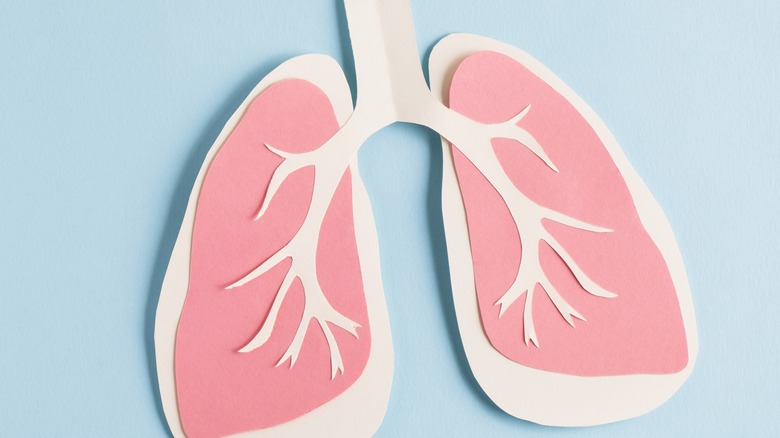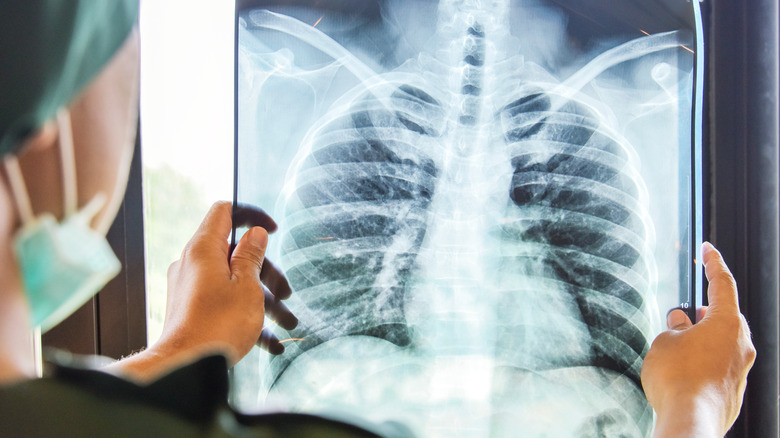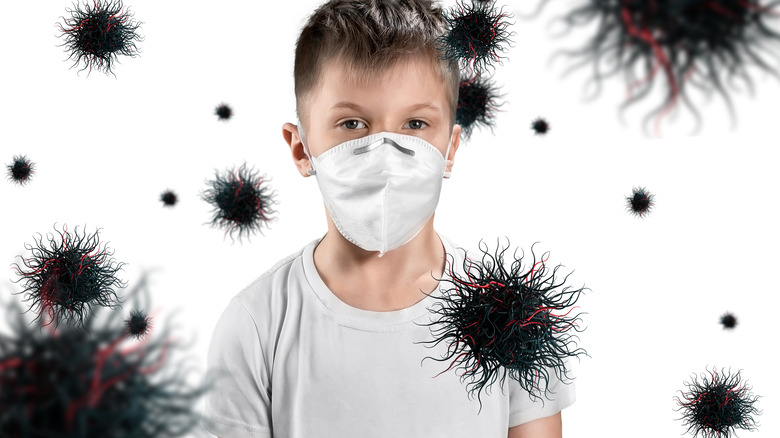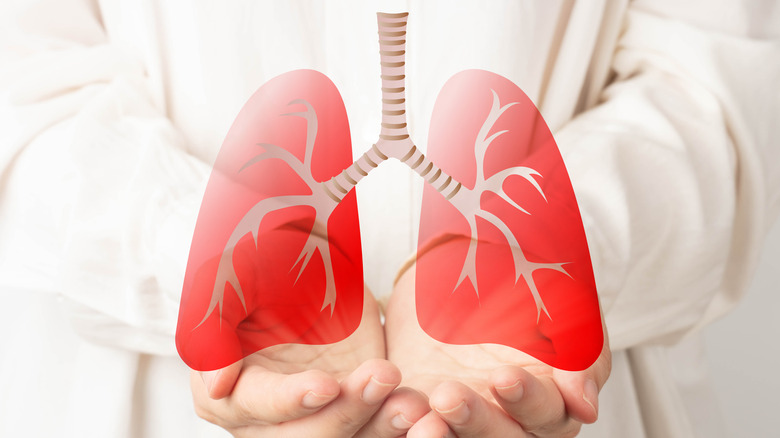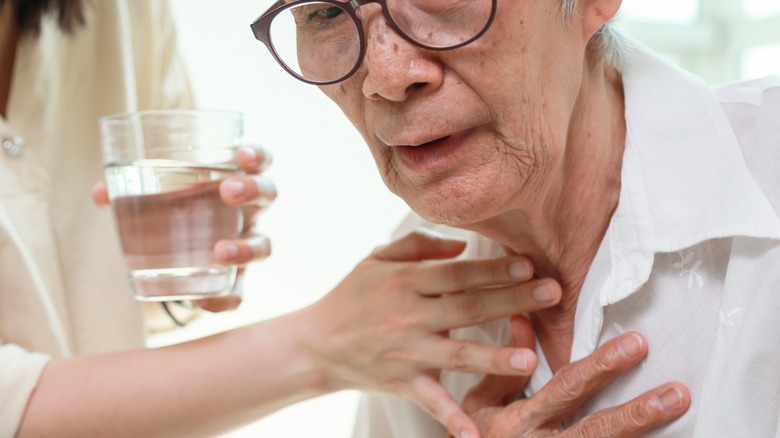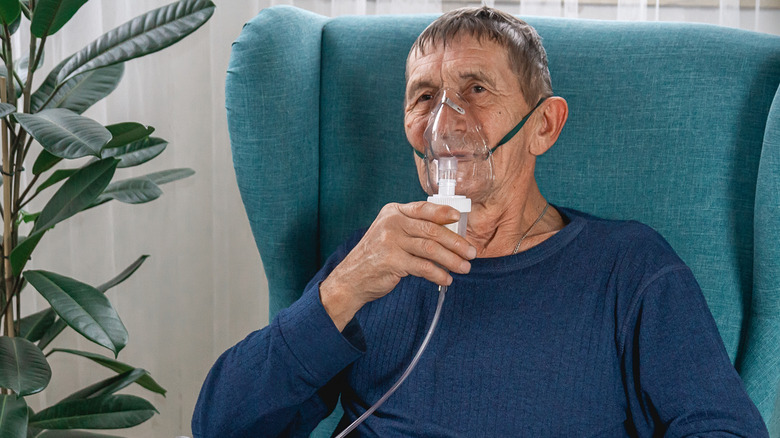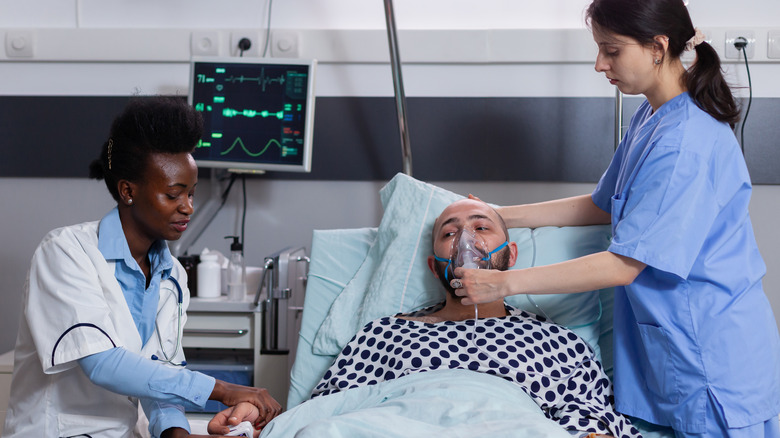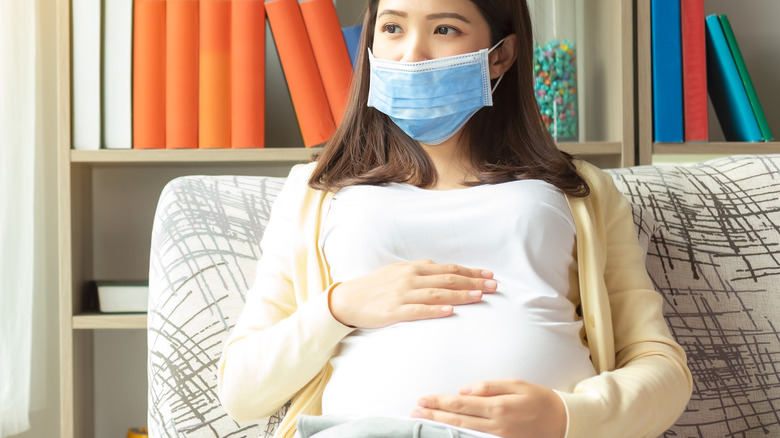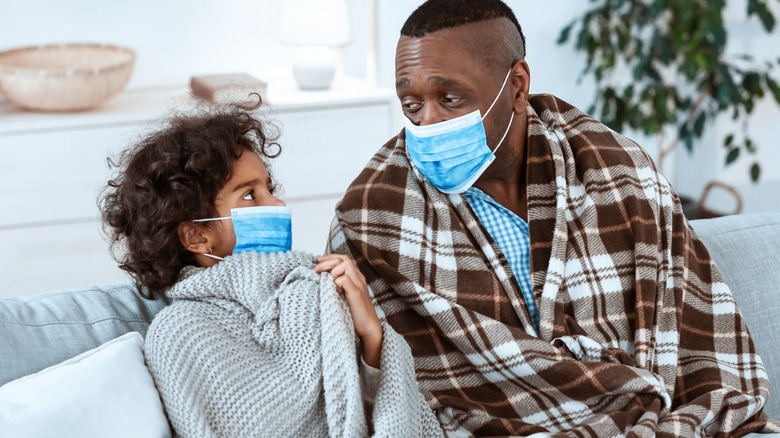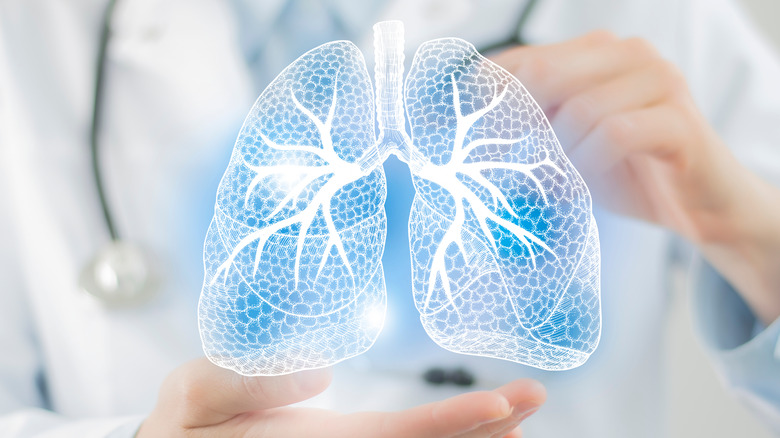Pneumonia Explained: Causes, Symptoms, And Treatments
The lungs are one of the main organs we use for breathing. Together with muscles, blood vessels, nerves, and lymphatics, the lungs are responsible for making sure that air is being properly circulated throughout the body. The National Center for Biotechnology Information (NCBI) explains that the lungs are a pair of sponge-like organs that can be found in the chest. They are covered by a membrane called pleura. The right lung has three lobes, while the left lung has two lobes. The lobes of each lung are further divided into segments, each containing a corresponding segmental bronchi. Bronchi are the air passages of the lungs, which originate from the windpipe (trachea) and end in tiny air sacs called alveoli. The alveoli are each surrounded by many capillaries, where gas exchange occurs.
Gas exchange is an important process that happens when you breathe. Blood cells in the capillaries load up oxygen from the lungs and transport it throughout your whole body. From there, the same blood cells will load up carbon dioxide and other waste products, travel back to the lungs, exchange it for oxygen, and the cycle repeats. The carbon dioxide and waste products get eliminated from the lungs whenever you exhale (via the National Cancer Institute).
The lungs are soft organs, but they are housed inside the rib cage, which protects them from getting easily damaged by external trauma. However, it's important to remember that the lungs are not indestructible, and they are still vulnerable to diseases like pneumonia.
What is pneumonia?
According to the NCBI, pneumonia is an infection of the lungs. One or both lungs can be affected, and the infection can cause your airways to swell and the air sacs in your lungs to fill with fluid. Pneumonia occurs when there is a disruption in the balance between the microorganisms residing in your lungs and the specialized cells and substances of your immune system that keep these microorganisms at bay.
Disruptions can include anything that weakens the body's immunity, compromises clearance of mucus in the airways, impairs the cough reflex, or causes secretions in the airways to accumulate. When any of these happen, pathogens can accumulate in the lungs and cause an infection. Macrophages (specialized immune cells) detect these foreign invaders and act quickly to try and protect the airway. They do so by promoting inflammation which, ironically, is what causes the signs and symptoms of pneumonia. Inflammation compromises the integrity of the capillaries in the lungs, causing mucus and other fluid to leak out and lead to congestion.
The Cleveland Clinic states that each year in the United States, close to 1 million adults are hospitalized for pneumonia. It is also the most common reason for hospitalizations in children, and the second most common reason for hospital admissions overall. Based on the latest data provided by the Centers for Disease Control and Prevention (CDC), influenza and pneumonia together is the ninth leading cause of mortality in the U.S., accounting for approximately 53,000 deaths in 2020.
What are the causes of pneumonia?
Pneumonia can occur following an infection caused by certain bacteria, viruses, and fungi. Transmission can happen when a person who carries pneumonia-causing pathogens spreads it to another person (via Medical News Today). Not everyone who comes into contact with a pneumonia-causing pathogen will develop pneumonia, though. It depends on a person's risk factors and health status. For instance, a person may only experience a mild cold.
According to the American Lung Association, the most common bacteria that causes pneumonia is Streptococcus pneumoniae, which alone infects over 900,000 Americans every year. The COVID-19 virus, influenza virus, and respiratory syncytial virus (RSV) make up the most common causes of viral pneumonia; and Pneumocystis jirovecii, Coccidiodes, Histoplasma capsulatum, and Cryptococcus neoformans are some of the fungal causes of pneumonia. Pneumonia caused by viruses is usually milder and shorter in duration compared to bacterial pneumonia. But viral pneumonia caused by the influenza virus can be fatal, especially in people with heart or lung disease and in pregnant women. A person with viral pneumonia can also become superinfected with bacterial pneumonia, which prolongs the course of the disease and causes symptoms of bacterial pneumonia.
A special type of pneumonia called chemical pneumonia is inflammation of the lungs caused by poisons or toxins rather than infectious pathogens. Per Mount Sinai, some of the substances that can cause chemical pneumonia include liquids (e.g., stomach acid), gasses (e.g., chlorine gas), small particles (e.g., dust, smoke, fumes), and exposure to chemical warfare.
The different types of pneumonia
There is currently no universally accepted classification of pneumonia. In fact, according to a 2016 article published in BioMed Central, different expert organizations classify pneumonia differently from one another. But per the NCBI, pneumonia types include community-acquired pneumonia (CAP), hospital-acquired pneumonia (HAP), and ventilator-associated pneumonia (VAP). All three are caused by infection in the lungs, but they differ on where a person gets it. As their names suggest, CAP is pneumonia that is acquired in the community, HAP is acquired in the hospital within 48 hours of being admitted, and VAP is acquired 48 hours after getting intubated.
Other types of pneumonia include atypical pneumonia and aspiration pneumonia. Atypical pneumonia is caused by certain bacteria such as Mycoplasma pneumoniae (which causes "walking pneumonia"), Chlamydophila pneumoniae (which is different from chlamydia), and Legionella pneumophila (which causesLegionnaires disease). They have been specifically designated as "atypical" because compared to a typical bacterial pneumonia, they may cause different symptoms, have different chest X-ray findings, or be susceptible to other types of antibiotics (via the American Lung Association).
On the other hand, aspiration pneumonia occurs when substances that were meant to be swallowed by a person end up going down their windpipe. As Medical News Today explains, pathogens can enter the lungs through this manner but can usually be expelled through coughing. This may be difficult to do for some people, and if the body is unable to get rid of these germs, the lungs get infected and pneumonia occurs.
Pneumonia caused by COVID-19
Certain viruses can cause pneumonia, and the COVID-19 virus is one of them (per Johns Hopkins Medicine). The COVID-19 virus, also known as SARS-CoV-2, belongs to the coronavirus family. Included in this family are SARS-CoV-1, MERS-CoV, and other viruses that can cause the common cold.
Since the development of COVID-19 vaccines and boosters, most people who get infected with the disease experience only mild symptoms like fever, cough, and fatigue. But for a small percentage of people, complications still occur such as pneumonia, bronchitis, acute respiratory distress syndrome (ARDS), sepsis, and bacterial and viral superinfections. Memorial Hermann states that pneumonia can occur in up to one in five people with COVID-19. COVID-19 pneumonia typically affects both lungs, and usually occurs one to two weeks after getting COVID-19. It tends to be worse than other forms of pneumonia, develops over a longer period of time, and causes extended days at the hospital.
Interestingly, researchers from a 2021 study published in Nature may have found an explanation as to why this happens. They proposed that when the COVID-19 virus infects cells in the lower airways, they take advantage of the body's immune response by transferring from one type of immune cell to another. Rather than helping the lungs to heal, these immune cells end up slowly spreading the virus to other parts of the lungs instead. Findings like these are important, especially since almost all deaths and morbidity brought on by COVID-19 are associated with pneumonia.
Who is at risk of developing pneumonia?
According to the National Heart, Lung, and Blood Institute (NHLBI), babies 2 years old and younger (especially babies who were born prematurely) are vulnerable to pneumonia because their immune systems have not yet fully developed. Likewise, adults 65 years old and over are at an increased risk because immunity naturally weakens as people grow older. People who live or spend a lot of their time in high-density places (e.g., dormitories, military barracks, prisons, shelters, nursing homes) are exposed to more people than usual, which increases their chances of catching the infection from those around them. Regular or prolonged exposure to polluted air or toxic fumes can increase your risk of getting pneumonia; people who work with animals, such as veterinarians, may also get pneumonia from the animals they care for.
Winchester Hospital says that you are more likely to develop pneumonia if you have medical conditions that impair your gag reflex (e.g., stroke, multiple sclerosis, amyotrophic lateral sclerosis, Alzheimer's disease), or weaken your immune system (e.g., HIV/AIDS, cancer, history of organ transplant). Other conditions that increase your risk include chronic obstructive pulmonary disease (COPD), asthma, diabetes, heart failure, liver disease, kidney disease, and obstructive sleep apnea. Smoking, exposure to secondhand smoke, alcohol abuse, and drug abuse increases a person's risk as well.
Although the reason is still unclear, Alaska Native, African American, and certain American Indian children seem to be more likely to develop pneumonia compared to other children (per the CDC).
What are the signs and symptoms of pneumonia?
The signs and symptoms of pneumonia can be as mild as a cold or become really severe. Since pneumonia is an illness of the lungs, coughing is a common symptom (per the Cleveland Clinic). It is also not unusual to develop a fever. The cough of someone with bacterial pneumonia usually contains mucus that may be yellow or green in color, and may sometimes contain some blood. On the other hand, the cough of a person with viral pneumonia usually begins as dry, and may eventually contain mucus a day or so later. In terms of fever, bacterial pneumonia typically presents with high fever at its onset, while viral pneumonia usually starts as a low-grade fever that may worsen later on.
Other possible signs and symptoms of pneumonia include chills or shaking, difficulty catching your breath, breathing fast, fatigue, tiredness, weakness, headache, loss of appetite, sore throat, sharp or stabbing chest pain (especially when you cough or take a deep breath), muscle pain, sweating, rapid heartbeat, and bluish discoloration of your lips or fingernails (via WebMD).
According to Pfizer, a classic case of viral pneumonia affects both lungs, while a typical case of bacterial pneumonia affects just one lobe or section of a lung. Although the signs and symptoms of pneumonia may differ slightly depending on the cause, it's still important to remember that these differences are not the sole basis for diagnosing the disease.
How is pneumonia diagnosed?
A doctor will be able to diagnose pneumonia by first asking about your medical history (per the American Lung Association). Important things they look for include any risk factors you may have or exposures (e.g., travel, close contact with sick people) that may have caused you to get sick. This is followed by a physical examination, where they will pay close attention to your lungs. They will use a stethoscope to listen to your breathing and look for any abnormal sounds. If you have pneumonia, a doctor may hear crackling, bubbling, or rumbling sounds as you take in a deep breath. They will also place a pulse oximeter on your finger, which shows if you have enough oxygen in your body.
In order to confirm pneumonia, a doctor will need to order specific tests. A blood test will show if you have an existing infection, a sputum test (where you provide a sample of mucus by expelling it through deep coughing) will determine what is causing the infection, and a chest X-ray will provide an image of your lungs to see where and how severe the infection is (via WebMD). A doctor may also request additional tests if you are in the hospital, have severe symptoms, are over 65 years old, or have other medical conditions. These include an arterial blood gas to check your blood's acid-base balance, bronchoscopy to directly visualize your airways, and a CT scan for a clearer picture of your lungs.
How is pneumonia treated?
Pneumonia is treated based on its cause and severity, your age, and your current health status. The goals of pneumonia treatment include relieving your symptoms, eradicating the infection, and preventing any complications. Depending on the cause, your doctor may prescribe antibiotics (for bacterial infections), antivirals, or antifungals. Per the Mayo Clinic, if you have bacterial pneumonia, it usually takes a few weeks to determine which specific bacteria is causing the infection, but your doctor will still give you antibiotics even before the results come out. If your symptoms are not improving, you may be switched to a different antibiotic. The NHLBI warns that if you stop your antibiotics prematurely or if you don't take your antibiotics as prescribed by your doctor, your pneumonia may come back even if you have started feeling better already.
To relieve your symptoms, a doctor may advise you to drink lots of fluids, drink warm beverages, use a humidifier, take a steamy bath, avoid smoking and exposure to secondhand smoke, and get plenty of rest. They may suggest over-the-counter fever-reducers like ibuprofen, aspirin, or acetaminophen (via the American Lung Association). However, never give children aspirin: It is damaging to their brain and liver, and may cause a condition called Reye's syndrome.
If you only have mild pneumonia, a doctor will prescribe medicines for you to take at home. But if your pneumonia is severe, you may need to be admitted to the hospital for more intensive treatment and close monitoring.
Complications of pneumonia
Per the latest data by the CDC, close to 8 out of 1,000 emergency department visits are due to pneumonia. While most people are able to recover fully, some are more susceptible to experiencing prolonged infections or developing complications. These include older adults, infants and young children, people with weak immune systems, and those who have underlying health conditions like COPD, diabetes, and cirrhosis (per Johns Hopkins Medicine).
WebMD enumerates the possible complications of pneumonia. Bacteremia (infection of the blood) may occur in bacterial pneumonia. As the infection spreads, sepsis or septic shock may occur, which can cause your blood pressure to drop dangerously low and prevent your heart from effectively pumping blood. This is a medical emergency, and should be treated in the hospital. Another complication of pneumonia is the formation of lung abscesses. These are localized collections of pus in your lungs that may need to be drained. Pneumonia may also cause pleural effusion (fluid between the lungs and the pleura), empyema (infected pleural effusion), and pleuritis (inflammation of the pleura). If your lungs continue to fill with fluid, they will eventually stop functioning which may lead to respiratory failure.
Healthline adds that pneumonia can worsen certain long-term illnesses like congestive heart failure and emphysema (a subtype of COPD), and may increase the risk of heart attack in people with these conditions. Lack of circulating oxygen, as well as widespread infection seen in severe pneumonia, may also cause the heart, liver, and kidney to fail.
What happens when I get hospitalized for pneumonia?
According to the Mayo Clinic, if you have pneumonia, you may need to be admitted to a hospital if you are over 65 years old, are feeling confused, have low blood pressure, have weak kidneys, are breathing fast, need respiratory support, have a low body temperature, or have a slow heartbeat. Children with pneumonia who are younger than 2 months old, are sleeping more than usual, have difficulty breathing, have low oxygen levels, or are dehydrated may also need to be hospitalized.
During your first day in the hospital, you may have your chest X-ray taken and your blood drawn. You may also be asked to provide a sputum sample. Your designated healthcare provider will examine your lungs, check your blood oxygen levels, and take your vital signs. Depending on what they find, you may be given medicines to control the infection and relieve your symptoms, and oxygen or other breathing treatments. Throughout your stay, your vital signs and health status will continuously and regularly be monitored to check for signs of improvement or decline. If your test results and symptoms have improved, you may be discharged as early as day three. If not, you will be asked to stay until you feel well enough to go home (via Intermountain Healthcare).
You may still have symptoms after you go home from the hospital, which is why it is important that you take any take-home medications prescribed to you by your doctor.
Pneumonia in pregnancy
Pneumonia in pregnancy, or maternal pneumonia, can cause complications to both the mother and the baby. Pregnant women are at an increased risk of developing pneumonia because pregnancy can weaken a woman's immune system, and can compress the lungs as the womb gets bigger. Other things that can increase a pregnant woman's risk of getting pneumonia include smoking, low blood levels (i.e., anemia), preexisting asthma and other long-term conditions, exposure to young children, and prolonged stays in hospitals or crowded places (via Medical News Today).
Healthline warns that maternal pneumonia can be fatal to expectant mothers. It may also cause premature birth, low birth weight, respiratory failure, and miscarriage of the baby. The symptoms, diagnosis, and treatment of maternal pneumonia are very similar to pneumonia outside of pregnancy, usually with no variation between the different trimesters. Although it is understandable to worry about your unborn child being exposed to radiation, it is important to know that a chest X-ray is generally a safe procedure to have during pregnancy.
You should call your doctor immediately if you start experiencing symptoms of pneumonia, if your baby is moving less frequently, if you feel pelvic pain or cramps, or if you have vaginal bleeding or fluid leakage. Go to the nearest emergency department right away or call 9-1-1 if you start experiencing belly pain, chest pain, breathing problems, high fever, vomiting for more than 12 hours, dizziness, confusion, or if you are unable to feel any movement from your baby.
Pneumonia in children and in older adults
Although the causes, risk factors, diagnostic tests, and treatments of pneumonia are virtually the same, children and older adults with pneumonia may present differently compared to other age groups (per the Cleveland Clinic). Newborns are more likely to get bacterial pneumonia, while viral pneumonia is more likely in young children. Apart from the usual fever, cough, fatigue and chest pain, children may experience problems with breathing that can present as flaring of their nostrils and paradoxical movement of their chest as they breathe (the chest wall moves in as the child inhales and moves out as the child exhales). They may also have wheezing, vomiting, and flushed skin. An infant or toddler with pneumonia may exhibit difficulty in feeding, restlessness, fussiness, grunting, noisy or rattly breathing, decrease in urine output, and pale skin. They may also temporarily stop breathing in their sleep, cry more than they normally do, and appear limp.
Pneumonia can be harder to identify in older adults. The signs and symptoms are somewhat different, and may be less specific. These include weakness or unsteadiness (which can increase the risk of falls), absence of fever or lower body temperature compared to normal, delirium, functional decline (i.e., decreased ability to perform daily activities), and inability to hold urine. Compared to other people, adults over 65 years old are more likely to get hospitalized and die from pneumonia, which is why it's important to seek medical help as soon as possible (via Healthline).
Can pneumonia be prevented?
Pneumonia can be prevented, and the best way you can protect yourself from developing it is by getting vaccinated, practicing good hygiene, and observing healthy lifestyle practices.
The CDC states that vaccines are widely available for the most common causes of viral and bacterial pneumonia. These include vaccines against the COVID-19 virus, the influenza virus, the varicella virus, Haemophilus influenzae type b (Hib), measles (MMR), pertussis (i.e., whooping cough), and Streptococcus pneumoniae (pneumococcal). There are two types of pneumococcal vaccines: conjugate (i.e., PCV13, PCV15, and PCV20), and polysaccharide (i.e., PPSV23). The conjugate vaccine is recommended for children under 5 years old and children 5 to 18 years old with health conditions that increase their risk of infection. PPSV23 is recommended for children 2 to 18 years old who also have underlying conditions that increase their risk of pneumococcal disease. Adults over 65 years old and adults over 18 years old who have certain illnesses or risk factors should receive PCV15 or PCV20 (if they have never received any conjugate vaccine in the past); and PCV15 should be followed by a dose of PPSV23. It's a lot to keep track of, but your doctor will know which vaccine is right for you.
Additionally, the American Lung Association advises frequent handwashing, avoidance of smoke, and awareness of your overall health status. Keep your body healthy by having a proper diet, adequate rest, and regular exercise. A healthy body can prevent infections and promote faster recovery from disease.
If it isn't pneumonia, what else can it be?
Pneumonia can often be confused with a cold or the flu, but these three conditions are different from one another. According to the University of Northern Colorado (UNC), fever and headaches are rare when a person has a cold, and it usually presents as a stuffy or runny nose, sore or itchy throat, mild chest discomfort, cough, and gradual onset of symptoms. On the other hand, a person with the flu will most likely have high fever, headache, muscle pain, and rapid onset of symptoms. A cold is typically caused by a virus (e.g., rhinovirus), while the flu is caused specifically by the influenza virus. Viruses that cause both colds and the flu can also cause pneumonia, and a person with a cold or influenza may develop pneumonia as a complication of their disease.
According to Medscape, pneumonia shares similar signs and symptoms with other medical conditions. These include asthma, atelectasis (collapsed lung), bronchiectasis (permanent damage to the lungs), bronchiolitis (inflammation of the bronchioles), bronchitis (inflammation of the bronchi), COPD, croup (swelling of the windpipe), epiglottitis (inflammation of the epiglottis), and foreign body aspiration (foreign body in the lungs). The NCBI adds that pneumonia may also present similarly to pulmonary edema (fluid in the lungs), cancers, and pulmonary embolism (blockage of an artery that supplies the lungs). A doctor will be able to determine which disease is causing your symptoms using a series of diagnostic tests, and treat you accordingly.

